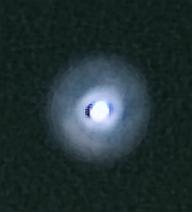Last updated: 28 March 2005
|
|
Last updated: 28 March 2005 |
Some LXD55 users have sent me examples of their astrophotography. If you have some examples you would like included here please send me a description of how you made the astrophotos and a copy of the images as GIF or JPEG files (due to internet email gateway issues, please send only one image file per message or ZIP or Stuff multiple files). Send to mweasner@optcorp.com. Alternatively, if you have created your own web page with your examples please let me know and I'll include a link to your site.
| Submitted by: Dieter.Wolf@DNSint.com (Dieter.Wolf@DNSint.com) [28 Mar 05] |
|---|
|
finally we got 'moderate' spring temperatures in southern Germany so it's
more comfortable to setup the scope and go outside.
This one shows NGC 2392, the 'Eskimo' or 'Clown Face' planetary nebula in Gemini. The first view in the telescope with low magnification shows an extremely blueish 'fuzzy' star south of an 8m.3 'normal' star. Higher magnifications show the bright central part with the inner ring and looking precisely you will see the much weaker outer ring. 2005-03-15; 21:30 CET; LXD55 SN-10 with ToUCam SC1 at prime focus; 20 of 150 by 10s exposures |

|
|
The second star close to the nebula is 13m.5 and stars are visible down to
16m.
The second photo is enlarged to better show details of the nebula like a dark lane and brighter regions in the outer ring (which are 'real' if you compare them to photos with larger equipment). |

|
|
What to do better next time? With about 9m.5 photographic and 40" outer diameter (about the size of Jupiter in the sky) this bright but small planetary allows / requires f/10 ratios instead of the f/4 which I used. And it would be a good idea to combine short exposed images of the bright central region with longer exposed for the second / outer ring. Thanks for your work / site Mike and always clear skies to all of you, Dieter (Munich, Germany) |
| Submitted by: Offwork11@aol.com [23 Feb 05] |
| Taken with Nikon D100 piggy backed to lxd55 10 inch reflector. In my light polluted back yard in Virginia Beach VA. 50 sec unguided shot at 800 ISO, 70 mm with a 70 mm to 300 mm lens. All set to manual.12 Feb 2005. |

|
| Submitted by: Mark Trudgett (m.t.trudgett@optusnet.com.au) [15 Jan 05] |
|
I lashed out and bought myself a Meade DSI and the night after it arrived, I managed to get out with my LXD55-SN10 and take the attached photos which despite an annoying breeze came out, I think, quite well especially for a first attempt! The Tarantula image [top] is a composite of 29 x 30s exposures and Eta Carinae was 20 x 30s exposures both at prime focus. The Eta Carinae image [bottom] is a mosaic of three composite images the DSI appears to have about the same field of view as a 6mm eyepiece.
The only problem that I had with the DSI was that I had to shut it down and restart a couple of times to reset the live view, tracking and focus but I was probably doing something wrong as I hadn't read the manual thoroughly! It wouldn't be easy to use for someone who hasn't already done some CCD/Digital Camera imaging but once the basic concepts are understood, it's a breeze!
I'm really looking forward to getting out and taking some more photos in the southern skies for all you northerners! |

|
| Submitted by: Dieter.Wolf@DNSint.com [15 Jan 05] |
|
This rich open cluster in Auriga with about 500 stars a total and 150
greater 12m.5 in an area of nearly a moon's diameter looks like a
'nebulosity' in small binoculars and like a dense 'package' of stars in
greater ones. Most of the stars a A...B class but there are some orange
giants too like the brightest one - 9m - in the center of the cluster.
The photo was shot from my suburban garden on 2005-01-10 22:00 CET with MEADE LXD55 SN-10 and PHILIPS ToUCam SC1 at prime focus, 5x10s |

|
Go to the August-October 2004 Guest Deepsky Astrophotography Page.
Go to the March-May 2004 Guest Deepsky Astrophotography Page.
Go to the 2003 Guest Deepsky Astrophotography Page.
Go to back to my LXD55 Home Page.